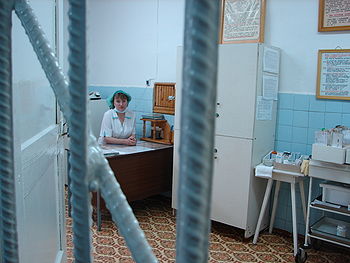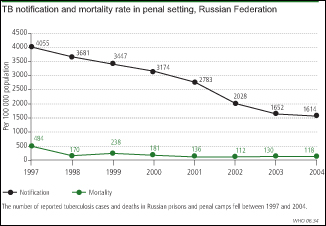Tuberculosis in Russian Prisons
Introduction
Authored by: Christopher Murphy
Mycobacterium tuberculosis is considered one of the most deadly infectious diseases. It spreads person to person, its only reservoir, through aerosol transmission when an infected person sneezes, coughs or talks. Over the course a year a person with tuberculosis can infect 10-15 people. The bacteria can last in the air for days and travel over great distances. At least 10 cells of the bacteria need to reach the lungs' alveoli in order to infect. The lungs provide a conducive environment for infection due to the high levels of oxygen. There are several levels of tuberculosis that vary on their severity. A latent infection means that the bacteria exists in the body but the immune system has suppressed it. There are different levels of active/susceptible tuberculosis, which include multi-drug resistant (MDR) and extensively drug resistant(XDR). Multi-drug resistant tuberculosis is resistant to first line drugs, more powerful and more expensive second line drugs are needed. Extensively drug resistant tuberculosis is essentially impossible to treat.[2]
Humans have suffered heavily from this disease throughout history. More specifically, during the "White Plague" of 17th and 18th centuries, tuberculosis was responsible for 25% of adult deaths and few people escaped infection. Over time tuberculosis began to disappear with the improvement of living conditions and the development of antibiotics. Yet today roughly 33% percent of the world has latent tuberculosis; however, as long as the immune system is not compromised, the infection will not develop. In 1993, the World Health Organization announced tuberculosis to be a global emergency. This was due to a rise in multi-drug resistant TB as well as an increased number of AIDs cases.[2] For instance, in recent years, starting after the fall of the Soviet Union, there has been a reemergence of tuberculosis in Russia. One of the most conducive breeding grounds for tuberculosis has been prisons. However, prisoners are not the only ones that need to be concerned, the tuberculosis is likely to spread to the rest of society through released prisoners and prison and hospital workers. [1] Although the current conditions in Russia are not favorable efforts are being made to reduce the gravity of tuberculosis.
Why Tuberculosis is so prevalent in Russia
Tuberculosis is an opportunistic infection, relying on the exploitation of compromised immune systems, thrives in stressful and impoverished regions. Sizable populations, inadequate nutrition, continual stress, tight and squalid living areas, the use of intravenous drugs, alcoholism and co-infections(HIV/AIDS) all contribute to compromised immune systems. Russian prisons possess all of these risk factors. As a consequence of severe penal codes and lack of funds, these prisons are overcrowded and sordid. The severity of the penal code is demonstrated bt the example of a prison sentence that resulted from the theft of a cell phone. Approximately 33% of the world has latent tuberculosis; therefore, it is likely that when prison populations increased in the 1990s, many of the inmates carried tuberculosis. Consequently, a large amount of people were crowded together in extremely uncleanly conditions, contributing to uniquely high stress levels. Yet, little has been done to improve the conditions in prisons, due to the stigma towards prisoners. The isolation of prisoners is less than ideal as all the infected prisoners are sometimes housed together causing re-infection, but occasionally those making a recovery will be separated. [1]
The prisoners face very high risks of contraction. They are 58 times likelier to contract tuberculosis than the average Russian citizen and are 28 times likelier to die from the disease. The number of TB cases has reached an epidemic level. As of 1999, the Russian prison population neared 1.1 million prisoners, of which 1 in 11 have tuberculosis. This is due to sporadic treatment. Consequently, MDR strains have arisen affecting 20,000 prisoners. The prison population surged above one million. Similarly, the movement of people being incarcerated and being released numbered in the millions. The strict penal codes in addition to the dire economic state of Russia only added to this number. As a result, prisoners with latent infections could no longer had the immune strength to suppress the TB and other prisoners became infected by being in such close proximity with sick prisoners.[1]
The recent spike in cases may be attributed to the combined effect of the collapse of infrastructure in Russia after the fall of the Soviet Union and the release of prisoners who are inadequately treated for TB back into society. As a result of the collapse of Russian infrastructure the rates of alcoholism, unemployment, crime, incarceration and movement in and out of prison all increased significantly. Furthermore, health and social services ceased to exist only exacerbating the problem at hand. Diagnostic tests could not be afforded any more as well microscopes for sputum examination. Consequently, much of the treatment was ended prematurely leading to TB rates that topped the charts as the world's highest and MDR strains of Tuberculosis.[1]
To highlight the consequences of the effects of crime, prisons were deemed "epidemiological pumps" for the rest of Russian society. After being in cramped quarters inside prisons, released prisoners would return home to equally small apartment blocs. During the winters, these unventilated apartments served as breeding grounds for TB. Additionally, there is also the risk of workers at prisons and hospitals will become infected and transmit the disease to people outside of the prisons and hospitals. Russia had previously its satellites to produce antibiotics but with the collapse drugs and funding were both in short supply. The newly independent satellite republics no longer continued the barter trade with Russia for antibiotics.[1]
Another factor inhibiting the eradication of tuberculosis was the Health ministry's resistance to adopting the DOTS strategy. Surgery, in which part of the lung is removed, is the approved method of treatment in Russia despite the controversy this procedure warrants from the outside world. Doctors have also been skeptical about DOTS and have been adamant about using their own methods. Contrary to the Health Ministry, many of the local doctors were fine with participating in the DOTS strategy, however, many of the pharmacies ran out of supplies-even first-line drugs where in short supply[1].
Attempts of Fighting off Tuberculosis
Due to the lack of fund Russia has continued to struggle with tuberculosis until recently. In the late 1990s George Soros became a key benefactor to the treatment of tuberculosis. In addition, the work of Medical Emergency Relief International and Partners in Health in the area, as they experiment to develop a new TB program, has lead to success in defeating the disease. Russia has also heavily relied on the Eli Lilly and Company Foundation and the Global Fund to Fight AIDS, TB and Malaria. The creation of the Green Light Committee, a drug procurement consortium, has been crucial to the fight against Tuberculosis. Green Light Committee is compromised of WHO, U.S. CDC, ngos and pharmaceutical firms. The effectiveness of this program is highlighted by the drop in cost of patient care. Previously, treatment cost $10,000 to $15,000 and currently runs around $3,000 to $4,000. Through this committee countries such as Russia could afford medication, including the more expensive second line drugs to treat MDR-TB. This was the direct consequence of purchase contracts and subsidies. The general condition of hospitals has improved with increased funding from organizations such as Global Fund. Improvements include new lab equipment such as airtight closets to house sputum and technology for culturing. The handling of cases has also changed for the better, those with TB are sent back to the barracks while MDR-TB prisoners are isolated in the hospitals, 6 to 8 prisoners to a room. The goal of the international organizations is to counsel, help develop an infrastructure and empower Russia to be self-reliant.[1]
The DOTS program has been implemented and is usually the strategy of choice. It is an daily procedure in which 4 antibiotics are taken orally for 6 to 9 months under the care of a health official. It was first believed in the 1940s that the drug streptomycin was the cure until it was discovered that tuberculosis mutates and that multiple drugs were necessary. The logic is based on statistics and probability, the drugs attack the tuberculosis in several different places simultaneously. Tuberculosis is slow growing, only reproducing once a day, resulting in a lengthy therapy session. One new idea of treatment is the pursue the strategy of directing more attention to MDR-TB than susceptible TB. This strategy has been adopted by Russia and many other former satellite republics that collectively form the Commonwealth of Independent States. It is hoped that this method will begin to be adopted by other countries around the world as well as help reach the 2015 goal of cutting the TB's global prevalence and mortality in half. Partners in Health developed this technique called DOTS Plus, in which all MDR-TB cases are treated, this has lead to a more extensive and intensive treatment. It is considered a bolder and more costly procedure. Local doctors were encouraged first in the prison system and then all throughout the region. This program takes up to two years and requires 6 to 8 drugs. MDR-TB and TB are similar in their capability to be lethal, the main difference is that MDR-TB is much harder to treat than TB. There is more and more agreement that MDR-TB should be the form of TB to be concentrated on because in treating MDR-TB then TB will also be treated.[1]
The most important factor in a successful recovery from tuberculosis is the treatment is completed entirely. There are two main reasons that this does not occur sometimes. Generally, during the beginning months the majority of the tuberculosis bacteria is killed and the symptoms go away. Many patients stop taking the medications falsely believing that they are cured. However, some tuberculosis survives and makes a waxy coat and buries away in the lung. [2] Of the bacteria that does survive, there are mutant strains that are resistant to the drugs. When treatment is terminated early, these strains take over causing the tuberculosis to be more virulent. Additionally, patients may object to continuing therapy is that the DOTS drugs have adverse side effects such as hallucinations, nightmares and vomiting. [1]
Tuberculosis Studies
Case Study 1
Some of the most convincing evidence of the general risk factors of Tuberculosis and varying importance in Russia comes from the study "Risk factors for pulmonary tuberculosis in Russia: case-control". The study was a case-control study in which existing cases of a medical condition are compared with a control group of the same number and similar composition. The goal of the study was to find and rank the risk factors for pulmonary tuberculosis. The leading risk factors were low accumulated wealth, financial insecurity, consumption of unpasteurized milk, diabetes, living with a relative with tuberculosis, unemployment, overcrowded living conditions, illicit drug use and incarceration. Of these leading risk factors when considering the amount of exposure, consumption of unpasteurized milk and unemployment.[3]
Case Study 2
In the study "Rates of latent tuberculosis in health care staff in Russia" the goal was to find individuals with latent tuberculosis infections and the rates of infection to treat through chemo prophylaxis and cross-infection strategies. In a cross sectional study, risk of tb was compared between unexposed students, medical students, primary health care providers and TB hospital health providers. Results showed that the amount of exposure could be linked to the likelihood of having LTBI. Primary health care providers were more likely to have TB(39.1% or 90/230) than students (8.7% or 32/368) and TB hospital health providers (46.9% or 45/96) were more likely to have TB than the primary health care providers (29.3% or 34/115). In addition, TB laboratory workers also had high levels of tuberculosis (61.1% or 11/18). From the results it can be concluded that TB Health Care Workers are have the highest risk and precautionary measures need to be taken.[5]
Case Study 3
A major concern for using second line drugs to treat MDR Tuberculosis is that many of them cause adverse reactions because of their toxicity. Through a retrospective case series "Adverse Reactions among patients being treated for MDR-TB in Tomsk, Russia" explored this question. Of the 244 cases 76% were cured, 6.6 % failed, 4.9 % died and 11.5 % defaulted. 73.3% of all cases showed adverse reactions, 74.8% in patients that adhered (at minimum took 80% of prescribed doses) and 59.1% of those that did not adhere. It was found that these adverse reactions varied on the amount of drugs taken but had no effect on the outcome. [4]
Conclusion
There has been success in treating tuberculosis in Russia. With international help Russia will begin to be able to eradicate tuberculosis and improve the standard of living.
References
[1] ["Multidrug Resistant Tuberculosis in Russia". www.scientificamerican.com/report.cfm?id=tuberculosis-in-russia. 5 Dec. 2009] [2] ["Tuberculosis-can the spread of this killer disease be halted?". Microbes and Diseases Fact file 1] [3] [Richard Coker, Martin McKee, Rifat Atun, Boika Dimitrova, Ekaterina Dodonova, Sergei Kuznetsov, and Francis Drobniewski Risk factors for pulmonary tuberculosis in Russia: case-control study BMJ, Jan 2006; 332: 85 - 87. ] [4] [Adverse reactions among patients being treated for MDR-TB in Tomsk, Russia. S. S. Shin, A. D. Pasechnikov, I. Y. Gelmanova, G. G. Peremitin, A. K. Strelis, S. Mishustin, A. Barnashov, Y. Karpeichik, Y. G. Andreev, V. T. Golubchikova, T. P. Tonkel, G. V. Yanova, A. Yedilbayev, M. L. Rich, J. S. Mukherjee, J. J. Furin, S. Atwood, P. E. Farmer, and S. Keshavjee Int J Tuberc Lung Dis. 2007 December; 11(12): 1314–1320.] [5] [Rates of Latent Tuberculosis in Health Care Staff in Russia Francis Drobniewski, Yanina Balabanova, Elena Zakamova, Vladyslav Nikolayevskyy, and Ivan Fedorin PLoS Med. 2007 February; 4(2): e55. Published online 2007 February 13. doi: 10.1371/journal.pmed.0040055. PMCID: PMC1796908]
Edited by student of Joan Slonczewski for BIOL 191 Microbiology, 2009, Kenyon College.



